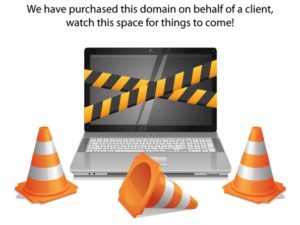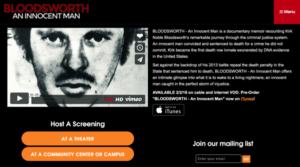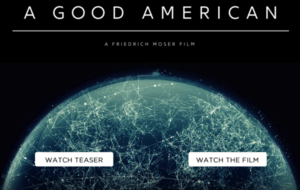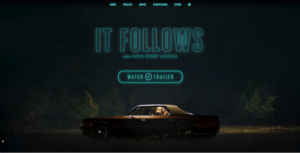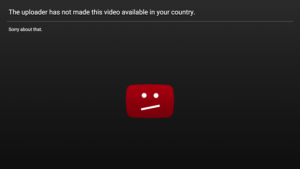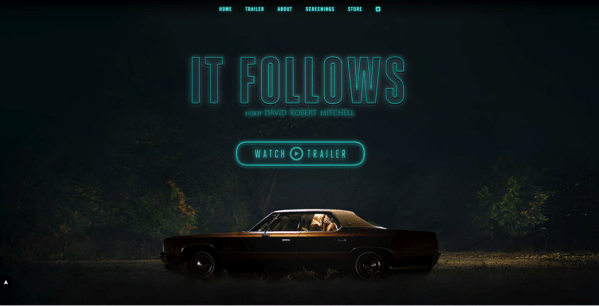
Distribution | How To's | Technology
Does Your Website Suck?
10 Critical Website Mistakes That Filmmakers Make & How to Avoid Them
Written by James Franklin and Kieran Masterton with introduction by Peter Broderick | Posted by: NewEnglandFilm.com
Your website can enable you to maximize your film’s distribution, build a powerful audience, and have a sustainable career. Unfortunately, few independent filmmakers understand the importance of having an effective website let alone how to build and maintain a great site. Hence, this invaluable guide—courtesy of Peter Broderick, James Franklin and Kieran Masterton.
“Independent film websites are frankly dreadful and getting worse,” is the latest assessment of an expert with a broad awareness of such sites. “They lack appropriate tone, goals, direction, voice, content, usability—the list goes on.”
Filmmakers are constantly asking me to point them to exemplary websites but there are fewer and fewer I can recommend. So I reached out to James Franklin, one of the world’s leading creators of independent film websites, and asked him to write a Distribution Bulletin on how not to design a website and how to fix the one you have (see also How Not to Negotiate a Distribution Deal). Together, James and Kieran Masterton have been building film websites for over ten years. Their company, Assemble, has done exceptional work for a host of independent features and documentaries, including CITIZENFOUR, Virunga, It Follows, The Square, Cartel Land, Dirty Wars, and How to Survive a Plague.
I’m very pleased to publish this invaluable guide. It will empower you to assess your website, identify what you have done wrong, and learn how to improve your site. The guide is a short crash course you can’t afford not to take if you want to achieve your site’s full potential.
— Peter Broderick, Paradigm Consulting
Mistake #1. Not Having a Website
This should go without saying but sadly it’s far more common than you’d think. The temptation is to think that you’ll leave stuff like this to the distributor or you’ll deal with a website once you’re in post or when you get into a festival, but this is a critical error. You need a website from day one, ensuring you connect with your audience early and giving you the time to build a relationship before your film’s release.
Your film’s website is many things to many people–it’s a hub connecting all the disparate social, commercial, distribution and marketing activities that happen all around the web. It’s your film’s home on the web and wherever someone might discover your film. It’s where you want your audience to ultimately connect with your film. This ensures the strongest possible connection between, you, your film and your audience.
And no, a Facebook page alone won’t do! Why? Because with Facebook, or any other social network, you don’t own your audience, you can’t take them from one project to the next, they’re locked into someone else’s network. Likewise, Facebook’s one-size-fits-all solution is not going to best serve your film or sell your film effectively. By all means have a Facebook page, but consider it one of many marketing assets, not your home on the web.
Whatever you do, don’t forget or put off creating a website for your film. Act now or you will be missing out on valuable early fans who could become influencers. Your website and mailing list are where the magic of serendipity happens.
Mistake #2. Failing to Define Clear Goals
This is about planning. Too often the strategy behind a film’s website is, “We need a big trailer and a link to buy,” but we all know selling films isn’t that easy. Likewise, a common approach is “I really like the website for film X or film Y, let’s copy that.” But what you really have to ask yourself is: what are the current goals for my film? Once you’ve established those goals, you can design how your site is going to help you achieve them.
Producing a website for an impact documentary that is in production and looking for finishing funds is very different from creating a website to sell a genre film direct to audiences in the Scandinavian market. You should plan your website carefully, lay out your current goals, whether that be funding, creating social impact, changing minds, promoting your film’s appearance in festivals or selling the film direct. The website design, layout, calls-to-action and language will all be very different depending on your goals.
Remember your site will evolve throughout the film’s life and should serve different goals at different times.
Checklist:
- Align your website design and layout with your current goals
- As your goals change, remember to change your website
Mistake #3. Forgetting the Basics
This is fundamental but all too commonly forgotten. What you should consider to be “the basics” is going to depend on the current goals for your film. That said, there are some golden rules:
Show us the trailer, don’t hide it away on a trailer page; your trailer is the best tool you have to sell your film. Don’t make a user click through to view it.
Whatever you do don’t forget contact information. It sounds simple, but it’s vital. Email is a must and a phone number is preferred – you never know, a sales agent might call. Adding a street address to your emails will reduce the likelihood of getting caught in spam filters.
Remember your press kit and press-specific contact information. At a minimum this should be the synopsis and a small but good selection of high-res photographic stills. The more eyeballs you can get on your film the better. Give the press the best possible resources to paint your film in the best possible light. Is your film screening atfestivals, and better yet, has it won awards? Don’t be shy, list your screenings, promote ticket sales, display your laurels with pride.
Don’t forget to make sure your site is as discoverable as possible. This means ensuring that each page of your site is optimized to give search engines the best chance of indexing them and accurately gathering information about them. The more optimized the content and the metadata on your pages, the more Google will reward you with traffic. Search engine optimization is a big subject. For more information read this guide to ensuring your site is discoverable.
Checklist:
- Make sure contact details are on the site
- Check your site’s search engine optimization (do a test search in Google)
- Check your site in social media (do a test share of the URL in Facebook or Twitter)
- Add your press kit, trailer, awards, reviews and showtimes
Mistake #4. Losing Control of Your Domain
This is a disaster, but a very common disaster. You’ve had an idea for a film and at the height of your excitement and motivation you register the perfect domain name. Two years of pre-production, planning, financing etc. pass and now you’re in production and you want to launch a teaser website– but what’s happened to that domain? It’s expired and someone is cybersquatting your domain – nightmare!
The other oh-so-common version of events is that an intern or assistant registered the domain to their Hotmail address and you’re not in contact with them anymore. Your domain is one of the cheapest, but most valuable things you’ll purchase for your film and a simple administrative error can see it slip through your fingers.
Make sure you register the domain yourself to an email address you regularly use, store credit card details with the registrar, and set the domain to auto-renew. These simple tips will stop you from losing such a critical asset.
Checklist:
- Register your domain using an email address you use regularly
- Set your domain to auto-renew
- Save your payment details
Mistake #5. Not Being Memorable
People don’t really want to buy from a faceless corporation, particularly one they’ve never heard of. A lot of filmmakers make the mistake of wanting to hide behind a company name or brand, thinking it makes them look more professional, but don’t forget,people really want to buy things from other people.
When it comes to art or entertainment, people buy from interesting, memorable people. There’s huge fatigue among consumers in the entertainment marketplace at the moment as a result of the ridiculous abundance of content. You have to stand out, you have to ask yourself what’s going to make people care. In a world where no one has any time and yet everyone is bored, how do you make you and your film unique?
You have to make your website personal, it has to about you and it has to be authentic. Show personality, include humor if that’s you, write in the first person, but most of all, you have to be memorable. Filmmakers like Franny Armstrong, Hal Hartley, Sally Potter and Kevin Smith have all achieved this in their own unique ways, but most importantly their personality is at the heart of how they promote themselves and their work.
The success that these and many other filmmakers have had is partly to do with the personal audiences they have built. Namely the followers they have, or the following their work has. Some have built this following through email, their website and social media. Buildinga personal audience brings huge benefits in terms of support, resources, finances, feedback and reach. This is the ultimate goal. Nurturing a personal audience will reap the rewards on each project, but also travel from film to film, building with each project. But having a personal audience requires showing some personality.
Checklist:
- When sending emails, use your voice and personality – be real, be authentic
- Review how your personality comes across in the website content
- Use design to inject personality into your site
Mistake #6. Not Having a Call-To-Action
A call-to-action is a piece of direction you give to the user viewing your website; it’s usually the action you want the user to take having visited a page on your site. The action should help you fulfill your goals. For example, a call-to-action could be “Watch now for $3.99” or “Back us now on Kickstarter!” or “Request our film when it comes to your city” – these are all strong, directive instructions to the user. It’s important each page on your site has a clear call-to-action. Don’t make the user think when looking at your website.
Some of the most common errors are: failing to link to where someone can watch or buy your film; overwhelming the user with too much choice; focusing on the wrong call-to-action (one that doesn’t serve your goals). For example, don’t put, “follow us on Twitter” front and center instead of “Rent my film on iTunes.” Be sure not to leave an old call-to-action on your site after a campaign or release window has ended. Don’t ask people to “back us on Kickstarter” after the campaign is over and don’t ask them to “request our film in your city” after your Tugg tour has finished. Make sure your calls-to-action change over time so they reflect your current goals.
Checklist:
- Don’t make people think
- Keep your calls to action simple and make sure you always have at least one
Mistake #7. Bad User Experience
Ugly design, bad user interactions, and confusing site navigation all contribute to poor conversion rates. The worse your design, the more confusing it is for users to interact with your site, the less likely they they will follow your calls-to-action. This ultimately means less sales, pledges, requests, follows, or mailing list sign ups; whatever it is you’re trying to achieve will be hindered by poor design and bad user experience.
Some key things to remember in order to avoid this problem:
Make your site’s design image driven, not text driven. Film is a visual medium and a creative product; you want to illustrate that with your design. This will also help when international audiences who don’t speak your language are viewing your website.
Maintain your film’s brand throughout – from your poster through your website and beyond. If you already have a poster, your site should use the same design style. Don’t forget your social networks- they should also be branded to create a visual connection with your other marketing materials. If users spot your trailer on YouTube and then Google your film, they should know that they’ve found the right film the instant your film’s website loads.
Ensure your site is mobile friendly. We’ve all been on the phone and followed a link on a social network to a film’s website only to be forced to pinch and zoom to read the text or play the trailer. This isn’t good enough. When you commission your site, it’s vital you make sure that it’s going to be designed to be responsive/adaptive. This will enable your site to respond and adapt to the size of the screen on which it is being viewed.
If you’re working with designers, help them determine the visual hierarchy of your site by discussing the most important content and where it’s placed. This should be driven by your current goals. Screen size plays a big part in how a user perceives the content on your site. Ask your designer how the site will look on mobile or tablet vs. on a laptop or desktop and and make sure all versions of the design achieve the film’s goals. If that goal is to sell VOD, are your calls-to-action front and centre on both mobile and desktop or are they buried and hard to find on mobile?
Mobile has now overtaken desktop as the most popular device on which to view media. At 51% vs. 42%, it’s vital that you ensure your site is accessible on mobile devices.
Checklist:
- Remember mobiles – check your site design on your phone and tablet
- Maintain brand or ‘look’ consistently across your site, social media, and VOD platforms
- Imagine you want to watch your film, how would do you it – check it actually connects up
Mistake #8. Not Thinking Globally
When you read about the latest hot indie film and follow the link to watch it, you don’t want to be greeted by a sad YouTube face or a generic “This content is not available in your region” message. Those living outside the continental United States are all too familiar with this experience. While the old world of film distribution is still focused on territory-based sales,it’s important to remember that the web is an international marketplace. You shouldn’t restrict your appeal to people from your country of origin, territories where you’ve sold your film to a distributor, or big markets like the US or UK.
Use geo-technology to be as inclusive as possible. Allow rights holders in different territories to control their release in that region but ensure that isn’t at the expense of those in the rest of the world. Releasing an international trailer with a mailing list sign-up piques audience interest, whereas a door-slam geo-blocking message infuriates your potential audience. It is also important to use inclusive language, offer internationalized pricing, and provide subtitles for your film to ensure you have the broadest appeal possible. Turn a geo-block into a geo-opportunity by asking people to sign up if the film isn’t available in their region yet. You can avoid making people feel unwelcome by using as much visual communication as possible, limiting your written content to the bare minimum, and using universal iconography to denote important functions such as buy, search, download, etc.
Ultimately, it’s about adapting your marketing to the global marketplace. This can be hard when deals with distributors appear restrictive and the technology seems daunting. Geo-detection can be used to block, but it can also be used to direct audiences to the best possible experience for them. For example, let’s say you’ve made a dark, indie thriller: you’ve had some festival success, and sold the rights to Sweden and the US. Those distributors want to exclusively promote the film in their region unimpeded by other distributors. You want them to do this as successfully as possible, after all that’s what they do best and it’s why you sold your film to them.
You also need to remember there’s an enormous audience for your film in the rest of the world. You should make sure your film is directly available from your website in all territories where no company has acquired the rights. What you need is one website that you control and has default content that’s displayed as standard around the world. The site should have an international trailer and a place to join your mailing list so that you’re growing your audience in every region of the world. The website should be capable of serving different content to users in different territories. These versions of the website should be sales focused and could be controlled by the distributors in each territory where you have a made deal.
Checklist:
- Geo-filter your site, trailer, and mailing list to adapt to users in different regions
- When traveling, try out your content, VOD platforms, and website from other countries
Mistake #9. Failing To Use Your Mailing List
Mailing lists can be extremely powerful.They are a fantastic tool to connect you to your audience and to sell effectively, but they have to be used correctly.
In the age of abundance, information overload is a real problem. Fear of missing out leads consumers to look for the most direct and effective means to find out about things they don’t want to miss. The best way to ensure this is to have news delivered straight to their inbox. For this reason alone, it’s vital that you have a mailing list and take the running of your list seriously.
All too often we hear, “I had a mailing list but it didn’t really work.” Without a clear strategy, a mailing list can quickly turn into a device for spam. Here are some vital points to remember when running a mailing list:
Share don’t sell. It’s all too easy to bombard your list with spammy, buy-buy-buy-style emails that make you look desperate. Instead, try to build a relationship as you would with a person- share your experience, insights, things you find interesting, and provide extra value through exclusive behind the scenes content. Think “would I want to receive this in my already crowded inbox?”
Keep screening information local to the subscriber. Collect a user’s location when they sign up for your list and ensure they only receive event information that’s relevant to them. There’s nothing worse than living in London and reading that there are 5 screenings happening next week in Boston.
Give things away for free. This can be valuable knowledge related to the content of your film, practical information on how you made it, or free posters with every Blu-ray order. Give the mailing list subscribers something nobody else has and give it to them for free, like you would a friend. The more generous you are, the more supportive they will be on this and future films.
Don’t underestimate the relationships that can be built using mailing lists, don’t spam people, and don’t maintain total radio silence. Deliver value to people’s inboxes and you’ll be rewarded.
Checklist:
- Set up your mailing list
- Give people a compelling reason to join it (rather than self-promoting updates)
- Set a calendar reminder to send out something every few months
- Review your extra content – can you share something for free?
Mistake #10. Not Starting Early
Haven’t got your film’s website set up yet? Start now! Start as early as you possibly can. Doing so buys you precious time to grow an audience, forge relationships, and encourage people to feel invested in your film. It allows serendipity to happen. It’s very easy to sit back and de-prioritize your film’s website, but ultimately getting an early start will translate into crucial fan support at every stage of your film’s lifecycle.
Usually, the first 100 people who discover your film and join the mailing list will be more valuable to your distribution efforts than the last 100 people. Think of that feeling you get when you discover a band before they become popular. The same is true with films. Early adopters will often be your keenest advocates and most loyal fans. If you don’t have a place for them to interact with you and your film early on, you will lose valuable opportunities.
As soon as you have a website, your audience will be able to start following your story. Your site will enable you to show them your personality, to be memorable, and to take them on a journey with you through the planning, making and distribution of your film.
Your film’s website is a powerful asset that develops with your film. It should never be an afterthought that you throw together without thinking. Starting early means that you can have your website help you achieve each of the vital goals you set for your film.
Checklist:
- Don’t go for perfect first time round, get something simple up early and build on it
- Give early adopters something to do, they will support you
My Website Checklist:
- Register the domain name as soon as you have a name for your film
- Use your email to register the domain and set it to auto renew
- Set up a simple website and mailing list as early as possible
- As you progress through each stage of your film, review the following:
- Does my website reflect my current goals?
- Have I updated my mailing list with what’s happening?
- Is my personality coming through?
- Is the design attractive and consistent across all my digital presence?
- When you enter the distribution stage, review the following:
- Can people find where to buy the film?
- Do the site and trailers work internationally?
- Should I be geo-filtering to make my site more friendly internationally?
This post was originally published at www.peterbroderick.com. Republished with permission.
Peter Broderick is President of Paradigm Consulting, which helps filmmakers and media companies develop strategies to maximize distribution, audience, and revenues. For more information, visit http://peterbroderick.com/.
James Franklin and Kieran Masterton have been building film websites for over ten years. Their company, Assemble, has done exceptional work for a host of independent features and documentaries, including CITIZENFOUR, Virunga, It Follows, The Square, Cartel Land, Dirty Wars, and How to Survive a Plague.









